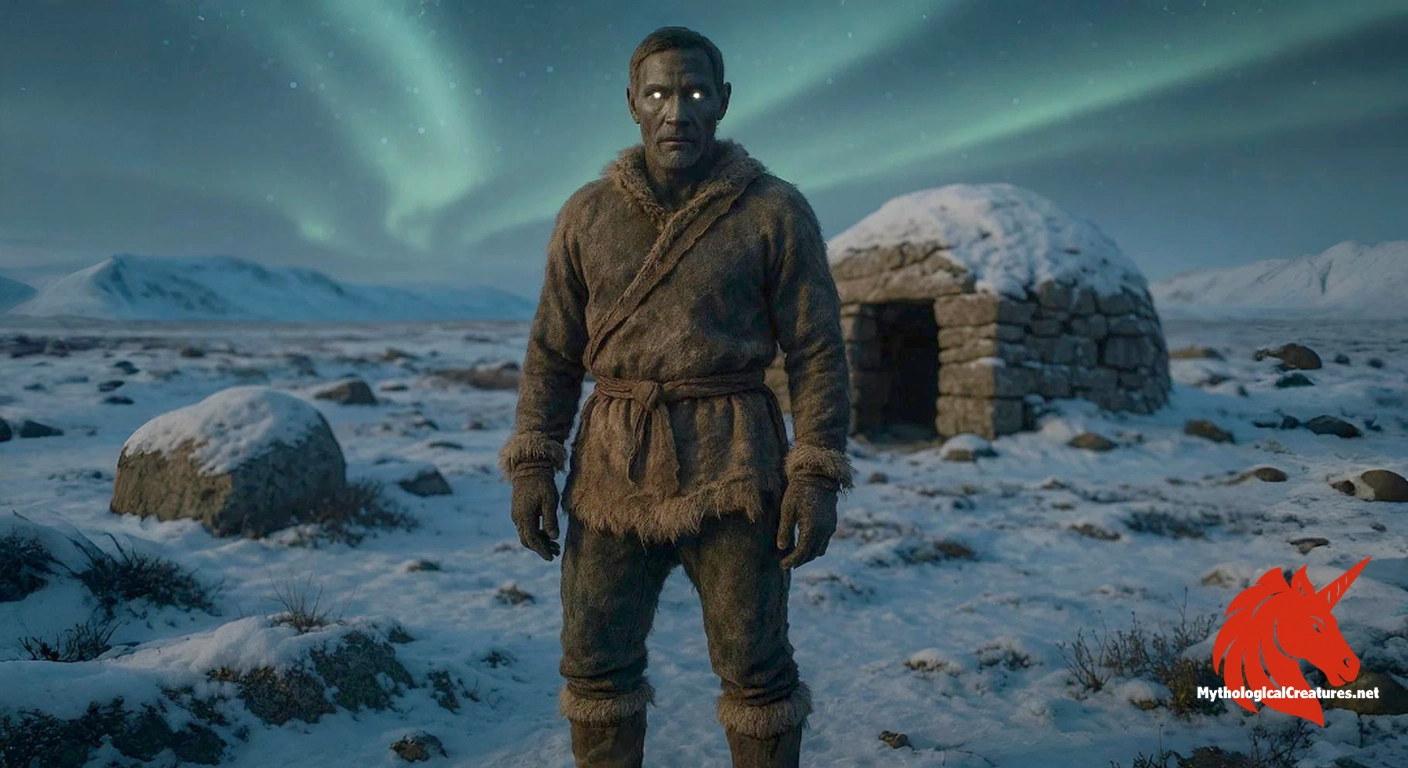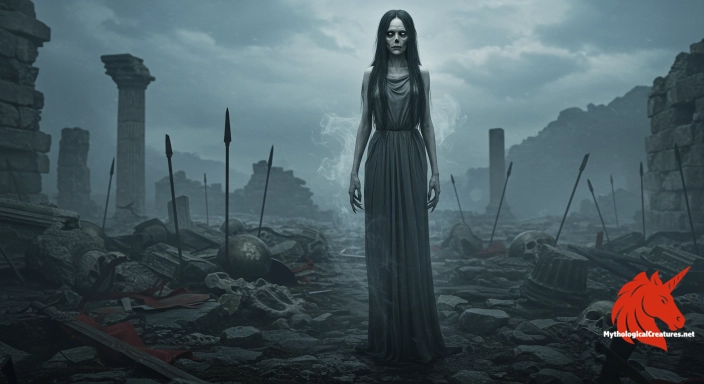Tariaksuq: The Tariaksuq are enigmatic humanoid beings from Inuit mythology known for their shadow-like invisibility.

Tariaksuq
Tariaksuq - The Tariaksuq embody themes of obscurity and dual existence, challenging ordinary perceptions of reality in Inuit lore.
Origins & First Encounters
The Tariaksuq emerges from the rich tapestry of Inuit mythology as a mysterious embodiment of both human familiarity and ethereal enigma. Its origins are interwoven with generations of oral tradition where the natural and the supernatural blend seamlessly amidst the stark Arctic environment. Early narratives paint a picture of a creature that mirrors the human condition—owning homes, maintaining familial ties, and partaking in everyday activities—while simultaneously inhabiting an unseen realm. Stories passed down through the ages highlight its uncanny ability to slip away into shadow when observed directly, setting it apart from ordinary folk. The creature is not merely a figment of imaginative lore but rather a symbolic representation of the fine boundary between the tangible world and an elusive alternate reality. Over time, the Tariaksuq has come to represent the duality of existence and the allure of the unknown, resonating deeply with communities that navigate the extremes of nature. Its presence in myth serves as a reminder of the hidden dimensions of life, where the familiar can suddenly become inscrutable. Every retelling reinforces the idea that even the most ordinary lives may harbour an element of mystery beyond the visible. In essence, the Tariaksuq encapsulates a philosophical meditation on perception and reality in a world defined by both harsh beauty and unseen forces.
Source Texts & Tale Variants
The narrative of the Tariaksuq is primarily preserved through the vibrant oral traditions of Inuit communities, where elders pass down nuanced accounts through storytelling. Early ethnographic records, though sparse, catch glimpses of this creature and hint at the broader mythos that envelops it. Diverse versions of the tale circulate, each enriched by local colour and subtle linguistic variations, with names such as Taqriaqsuk and Tarriassuq emphasizing its widespread recognition. These accounts have been transmitted over generations, ensuring that the myth endures despite the absence of a singular written source. Early anthropological and colonial observers occasionally noted uncanny reports of sightings and mysterious encounters, adding layers to its storied legacy. The sheer variety of narrative versions demonstrates how the Tariaksuq has adapted to the ever-changing cultural landscape of the Arctic. With each retelling, details such as its visibility only upon death and its half-animal transformations receive fresh emphasis. The mosaic of stories surrounding the creature reflects both the imaginative capacity of the people and the adaptability of their myth. As storytellers integrated environmental observations and social change, the Tariaksuq evolved into a multifaceted symbol of the unseen and the mysterious. These rich oral and fragmentary written accounts continue to inspire and intrigue, affirming the creature’s place in both historical and living traditions.
Form & Powers
The physical characteristics of the Tariaksuq straddle the boundary between the ordinary and the uncanny. In daily life, it resembles a typical Inuit human, complete with the clothing, tools, and domestic accoutrements that one would expect of a community member. Yet what distinguishes it is its unique interaction with light; when met with a direct gaze, the creature seems to vanish, leaving behind nothing more than an echo of a shadow. Remarkably, upon being slain, the Tariaksuq is said to reveal an astonishing hybrid appearance — a fusion of human features with those of a caribou, creating a startling half-man, half-caribou visage. Observers note that its form may feature elongated limbs and subtle, animalistic qualities that hint at a deeper connection with nature. Some traditions recount that its eyes carry an otherworldly glimmer, as though reflecting an inner light from a place beyond the earthly realm. Variations in physical descriptions suggest that its size and build might be as fluid as its presence, adapting to the ambient conditions of the Arctic night. The interplay between visible and invisible traits accentuates its dual identity and reinforces its role as a boundary figure between two distinct existences. Even the texture of its skin is described in rare accounts as bearing a faint, almost imperceptible coat reminiscent of caribou fur. Overall, the creature’s physicality is designed to intrigue and baffle, leaving a lasting impression of both beauty and disquieting mystery.
Regional Faces
Across the vast expanses of the Arctic, the myth of the Tariaksuq acquires distinctive regional inflections that reflect local cultural nuances and environmental challenges. In some Inuit communities, it is seen as an ordinary yet subtly extraordinary denizen of the world, blending into society with a quiet, almost unnoticeable presence. Other regions emphasise its role as a spectral hunter, a being whose ability to remain unseen heightens the mystery of its interactions with nature. In certain locales, the creature’s familial and communal attributes are highlighted, with narratives describing entire clans or households existing just out of normal sight. The diversity in naming—ranging from Taqriaqsuk to Tarriassuq—mirrors slight variations in its character and the lessons it imparts. Some communities view the Tariaksuq as a gentle, if elusive, guardian of the natural order, while others regard it with a wary respect that borders on superstition. These regional adaptations also align with the differing environmental realities, such as the shifting patterns of Arctic light and shadow. The manner in which it integrates into local ritual and art further underscores the adaptive qualities of the myth. Even as its details diverge from one community to another, a common thread of mystery and duality ties these accounts together. This regional tapestry lends the Tariaksuq a richness that highlights the dynamic interplay between local identity and shared mythic heritage.
Cultural Parallels
The myth of the Tariaksuq resonates with archetypal themes found in a variety of cultural traditions, particularly those concerned with the interplay of light and shadow. Its elusive nature and the concept of visibility only in death find echoes in other indigenous narratives of beings that dwell between worlds. Parallels may be drawn with tales of shadowy figures in European legends, which often explore the transformations that occur in the liminal spaces between life and death. Much like other mythic hybrids, the Tariaksuq embodies a fusion of human and animal characteristics, a motif that is evident in a number of global transformation myths. Its dual state of existence—visible only as a shadow or an altered posthumous form—invites comparisons with concepts of shape-shifters and spectral entities found in various cultures. The underlying idea that an ordinary being may conceal a profound otherness resonates widely and affirms the universal appeal of such narratives. These thematic similarities offer a fertile ground for comparative analysis, linking the shadow-people to broader questions of identity and transformation that many societies grapple with. The thematic motif of an ever-present yet elusive observer has inspired stories across different geographies and epochs. In drawing these comparisons, the Tariaksuq not only reinforces its own mythic significance but also contributes to a larger dialogue about the nature of existence and obscurity. This cross-cultural resonance helps to situate the creature within a broader pan-global tradition of enigmatic, boundary-defying beings.
Legacy & Modern Evolution
The portrayal of the Tariaksuq has undergone a significant evolution from its earliest oral recitations to its place in modern cultural discourse. In ancient narratives, it functioned as both a cautionary symbol and a mystical presence, weaving together elements of daily life with messages about the unseen forces that govern existence. As the influence of modernity and external cultural exchange grew, the creature’s image began to adapt—reflecting shifts in societal understanding while maintaining its foundational mystique. Contemporary interpretations have reimagined the Tariaksuq as a metaphor for modern existential dilemmas, symbolising the fragility and duality inherent in the human condition. Artistic representations in literature, visual arts, and even digital media have contributed to a renewed interest in this enigmatic being, framing it within a context that resonates with the challenges of contemporary life. The modern legacy of the Tariaksuq also encompasses its role as a cultural emblem, affirming indigenous identity and the timeless power of storytelling. Present-day festivals and exhibitions in some Arctic communities celebrate the lore of the shadow-people as part of a broader revival of traditional heritage. This enduring evolution underscores how the myth adapts to new cultural and environmental realities while continuing to evoke the mysterious forces of nature. As the narrative of the Tariaksuq grows more complex with each retelling, it remains a potent symbol of the ever-present interplay between the seen and the unseen. In this way, the creature’s legacy is not only a tribute to ancient wisdom but also a living narrative that continues to inspire inquiry into the mysteries of existence.
Interesting Fact
It is remarkable that the Tariaksuq remain completely invisible during life, only revealing their dramatic half-man, half-caribou form in death, a duality that challenges our conventional understanding of identity.
Quick Creature Info
Origin:
Features:
Associations:
Our Mythic Legendary Rating:

Also Sometimes Known As:
Habitat:
Supernatural Powers:
Physical Attributes:
Abilities:
Behavior:
Weaknesses:
Lore:
References
Discover Another Mythical Legend You May Not Have Heard Of?
Uncover the mysteries of ancient folklore and expand your knowledge of legendary beings from cultures around the world.
Dare to Meet the Keres....
Curated by the Mythological Creatures Team (rev. May 2025)
